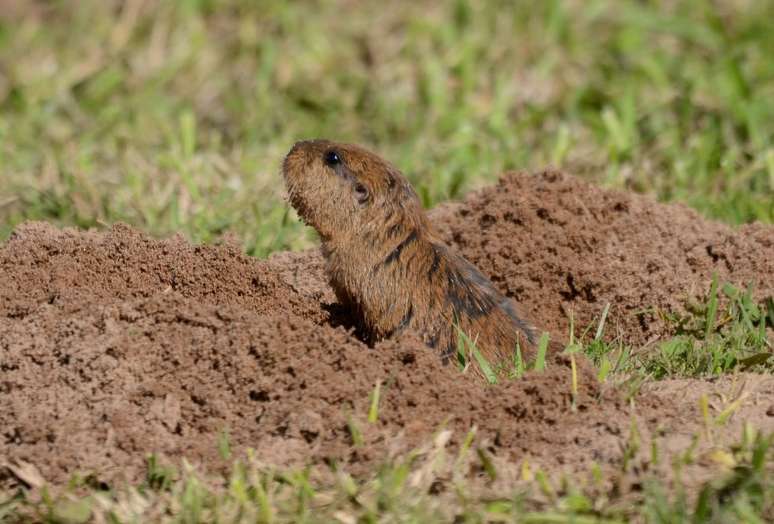Classified as vulnerable to extinction by the International Union for Conservation of Nature (IUCN) and the Chico Mendes Institute for the Conservation of Biodiversity (ICMBio), the species is at increasing risk of disappearance due to the reduction and fragmentation of its natural habitat.
Human influence on the environment continues at an alarming rate – and in the Pampas biome, this impact takes on dramatic contours in the case of tuco-tuco-do-lami (Ctenomys lami), a small underground rodent that lives only in the metropolitan region of Porto Alegre.
Classified as vulnerable to extinction by the International Union for Conservation of Nature (IUCN) and the Chico Mendes Institute for Biodiversity Conservation (ICMBio)the species is at increasing risk of disappearing due to reduction and fragmentation of their natural habitat.
Research indicates a worrying reduction
Driven by the curiosity to better understand the relationship between the animal and the transformations of the environment, the biologist Thamara Santos de Almeida revisited 28 historical areas presence of tuco-tuco-do-lami.
The result raised a warning: only eight subpopulations still resistWhile 15 have disappeared in recent decades. In other locations it was not possible to confirm the current presence of the species.
“The further apart these native fields are, the greater the likelihood of this happening [o tuco-tuco-do-lami] incapable of existing,” explains Thamara.
“More than the number of fields, what guarantees the survival of the animal is the connectivity between fragments. It is essential to restore and manage the plant corridors that unite the remaining populations.”
Described by science only in 2001the tuco-tuco-do-lami digs tunnels and underground passages, moving the earth and contributing to seed dispersal. Habit makes it essential to the dynamics of native fields of the Pampas.
Despite its resemblance to urban rats, it is a field animalharmless to humans. It lives in sandy areas of Porto Alegre, Viamão and Santo Antônio da Patrulhaand its low dispersal capacity makes it extremely sensitive to changes in land use.
“Since it already lives in restricted areas, any impact increases the risk of extinction,” the researcher points out.
The advancement of agriculture (mainly soybeans and forestry)THE urban expansionTHE highway construction and large infrastructure works are among the greatest pressures on the species. Relaxing environmental laws makes the situation worse.
“Without preliminary studies to identify insurgency areas, we run the risk of eliminating entire populations with projects that could be planned in other locations,” warns Thamara.
The scenario is critical: the tuco-tuco occurrence area reduced by 17%AND less than half of the potential habitat remains available. Between 1985 and 2019the Pampas biome has been lost 21% of native vegetationleaving alone 45% natural coverage.. According to the MapBiomas (2021)Pampa Gaucho almost lost 3 million hectares of native fields in four decades – the equivalent of approx 30% of its original surface.
The study proposes actions such as creation and expansion of Conservation UnitsTHE restoration of rural areas and the strengthening connectivity among fragments of vegetation.
“The Pampas is still an invisible biome in public policies, but its biodiversity can no longer be ignored,” says Thamara.
While the focus is on the tuco-tuco-do-lami, research reinforces its ecological value Pampa Gauchorecognized from above species diversity per square meter. Protecting the small rodent therefore also means protect an entire biome — vital to the environmental balance of southern Brazil.
International recognition
The work, considered pioneering on the species, was published in the international journal Mammalsby the publisher By Gruyter Brillspecialized in mammalian studies.
For Thamara the publication represents an important step in scientific dissemination and environmental awareness.
“The role of communication vehicles is essential in this process. They help teach, inform and inspire care for the environment,” concludes the researcher.
*With information UFRGS University Journal
Source: Terra
Rose James is a Gossipify movie and series reviewer known for her in-depth analysis and unique perspective on the latest releases. With a background in film studies, she provides engaging and informative reviews, and keeps readers up to date with industry trends and emerging talents.



![Everything starts here: What awaits you on October 13, 2025, Monday, Monday, 1282 episodes [SPOILERS] Everything starts here: What awaits you on October 13, 2025, Monday, Monday, 1282 episodes [SPOILERS]](https://fr.web.img6.acsta.net/img/2b/a2/2ba25ba2456a4d5c8d08b1428a26f86b.jpg)


